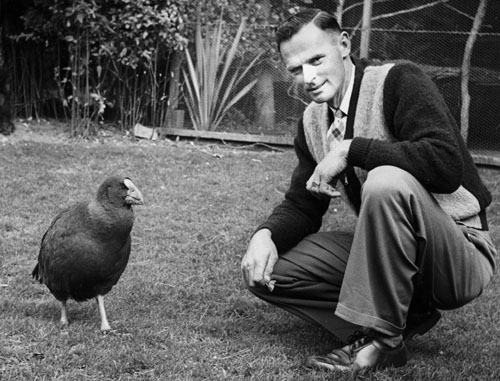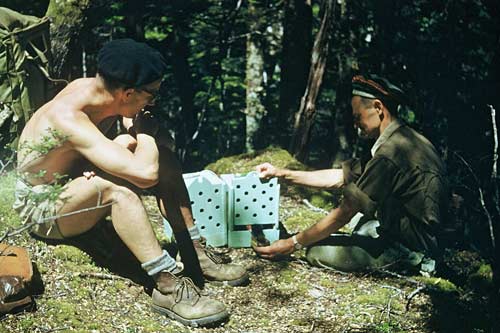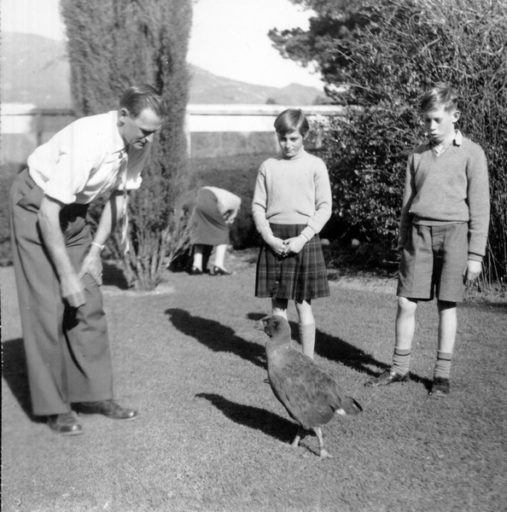Elwyn Welch was a Wairarapa farmer who loved birds. Most people have probably never heard of him, but back in the 1950s, he and his specially trained bantam hens had a vital role to play in the conservation and breeding of the recently rediscovered takahē. Elwyn and the bantams were recruited for a top-secret mission known as ‘Operation Password’.

When the takahē was rediscovered by Dr Geoffrey Orbell’s party in 1948 the news spread throughout the ornithological world. But, while the bird wasn’t, after all, extinct, it was only just hanging on to existence at the outer limits of its habitable environment. It was the only flightless, terrestrial herbivore to survive human colonisation and the ornithologists and government of the day were determined that it wouldn’t be lost (again).
In 1951, the government gave permission for a party to bring takahē chicks and eggs out of Fiordland for captive breeding and rearing. Elwyn Welch, amateur ornithologist and friend of well-known ornithologist Robert Falla, was the man chosen to attempt the incubation of takahe eggs.
Birds were Elwyn Welch’s passion. He was one of New Zealand’s paramount amateur ornithologists and commenced his practical conservation work by hand-raising grey teal chicks. By the mid-1950s, when the work he had carried out on his farm became better known, he was regarded as an expert in raising endangered species.
A ministerial visit was carried out to his Mt Bruce farm, ‘Kelvin Grove’, on the northern flanks of Mt Bruce. The official visitors looked over his farm and facilities and assessed the work with birds he had been carrying out privately. His appointment was approved.
For the next two years Elwyn worked at training bantams to stay sitting on a brood of hardboiled eggs in wooden carrying boxes – no matter what was happening to them or around them. He carried the birds in their nestboxes on the back of his tractor when he ploughed the paddocks. He put them on the roof-rack of his car and drove to the coast and back. Once, forgetting they were there, he drove straight into the garage, knocking boxes of bantams and eggs onto the ground.
His intrepid, dedicated bantams stayed sitting on their eggs!
In 1957, Welch, his bantams, biologist Gordon Williams and photographer Peter Morrison carried out their first expedition to retrieve takahē from Fiordland. There was some public opposition to these South Island treasures being taken north, so the retrieval operation was kept secret and code-named ‘Operation Password’.
In November 1957, Welch drove his Austin A40 car, with boxes, bantams and gear, to Wellington, crossed over on the ferry and drove to Te Anau. Next he and the bantams travelled by launch, then finally he carried the bantams and boxes by backpack into Takahē Valley, aided by Williams and Morrison.
They searched the valley floor but didn’t see a single takahē. So they stopped for lunch, sat down to eat and photographer Peter Morrison absentmindedly reached out a hand into the tussock – and felt something move. Two black takahē chicks!

Elwyn quickly wrapped the chicks in his jersey and returned to the hut to put the chicks with their bantam foster mums. The three men and their precious cargo drove back to Lyttelton, booked into a hotel under false names (the mission was top secret after all), and smuggled the nestboxes up the back stairs.
The next day they were late to board the ferry back to Wellington, but, so important was the mission, that strings were pulled and the ferry was delayed. ‘Operation Password’ was a success – but not a total success. The four takahē eggs they’d also collected on that first expedition failed to hatch, although one reached the stage where the chick could be heard cheeping inside the egg.
Undeterred, Elwyn Welch selected some more bantams for foster training and this time he trained them to sit on pukeko eggs.
The second expedition was carried out in 1959 with another epic journey by car, launch and on foot. This time the eggs were incubated, hatched and raised successfully by bantams – the world’s first artificially hatched takahē chicks. If anything, the bantams were just too successful as mothers. The takahē chicks imprinted on the bantams and wouldn’t breed with their own kind.
Encouraged by the success of the eggs and chicks, approval was given to transfer birds from Fiordland to Elwyn Welch’s farm, with the first birds transferred in July 1959. In May 1960, with takahē thriving at the Mt Bruce farm, the public were finally allowed to view them.
Huge numbers of people came to Mt Bruce to view the ‘back from extinction’ takahē. More than 13,000 people visited over a 3-week period in 1960. Encouraged by the public response, proposals were made to build a centre and display New Zealand birds. In 1962, the decision was made to relocate to the Mount Bruce Forest Reserve, a protected site since 1889 and just 2km down the road from Welch’s original farm.

So that was the beginning of the takahē captive rearing programme – the first such programme to be attempted in New Zealand and now the longest-running programme for any bird in New Zealand, possibly in the world.
Elwyn Welch died in 1962, aged just 36 years. He had felt the call to follow another of his passions – missionary work. A member of the Open Brethren congregation since his teens, Welch had studied by correspondence with the New Zealand Bible Training Institute. Elwyn and his wife Shirley decided to take their children, two daughters and a son, to Nigeria to work for the Sudan Interior Mission.
The Welches left for Nigeria in April 1961, where they ran a guest house for missionaries based in the interior of the country, as well as undertaking preaching duties. In early December Welch started suffering terrible night fevers. He had contracted bulbar poliomyelitis and he died at Jos, Nigeria on 10 December 1961, just seven months after leaving Wairarapa.
Known today as Pūkaha National Wildlife Centre, the modern-day research and breeding centre which had its beginnings on Elwyn Welch’s family farm, has now expanded to include a 942 hectare unfenced forest sanctuary for native wildlife. The forest is home to wild kōkako and kākā, while aviaries are used to breed endangered birds for release across Aotearoa New Zealand. In 1982, the visitor centre opened its doors to the public, followed by the Nocturnal House where visitors could see North Island Brown kiwi up close. North Island Kākā were released in 1996, the first successful translocation of the species.
In 2001 the entire forest became part of the wildlife reserve, extending the area from 55 to 942 hectares, increasing capacity to breed birds and diversified species. About 100 km of tracks were cut and thousands of traps and bait stations were scattered, setting up an area for wildlife with low predator pressure.
It’s a long way on from the days when a farmer ploughed his paddocks with bantams in nestboxes riding shotgun on his tractor. Elwyn Welch, amateur ornithologist, made a huge contribution to the conservation of one our rarest birds, but how many people today know about him? Elwyn, his bantams and the takahē is a story that deserves to be remembered.

